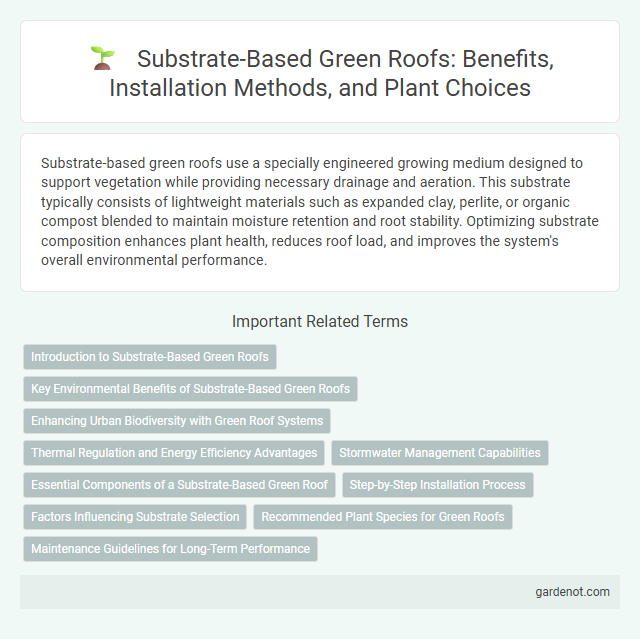Substrate-based green roofs use a specially engineered growing medium designed to support vegetation while providing necessary drainage and aeration. This substrate typically consists of lightweight materials such as expanded clay, perlite, or organic compost blended to maintain moisture retention and root stability. Optimizing substrate composition enhances plant health, reduces roof load, and improves the system's overall environmental performance.
Introduction to Substrate-Based Green Roofs
Substrate-based green roofs utilize engineered growing media composed of lightweight, nutrient-rich materials designed to support diverse vegetation while ensuring proper drainage and root aeration. These substrates typically include a blend of organic matter, mineral components, and additives that enhance water retention and structural stability, crucial for the roof's long-term health and performance. Proper substrate selection directly influences plant growth, biodiversity, and the roof's effectiveness in stormwater management and urban heat island mitigation.
Key Environmental Benefits of Substrate-Based Green Roofs
Substrate-based green roofs significantly improve urban air quality by filtering pollutants and reducing airborne particulates. These systems enhance stormwater management through high water retention capacity, mitigating runoff and decreasing the risk of urban flooding. By providing insulation, substrate layers contribute to energy savings and reduce the urban heat island effect, promoting cooler city environments.
Enhancing Urban Biodiversity with Green Roof Systems
Substrate-based green roof systems provide essential growing media that support diverse plant species, creating habitats for urban wildlife such as pollinators and birds. These green roofs improve urban biodiversity by facilitating ecological connectivity and reducing habitat fragmentation in densely built environments. Integrating native and adaptive plants within substrate layers maximizes habitat quality, promoting resilient urban ecosystems.
Thermal Regulation and Energy Efficiency Advantages
Substrate-based green roofs enhance thermal regulation by providing natural insulation through their growing medium, reducing heat transfer between the building interior and exterior. This insulation effect lowers energy consumption for heating and cooling, leading to significant energy efficiency improvements. Studies show substrate depth and composition directly influence the roof's thermal performance, optimizing climate control and reducing urban heat island effects.
Stormwater Management Capabilities
Substrate-based green roofs significantly enhance stormwater management by absorbing and retaining rainfall, reducing runoff volume and peak flow rates. Engineered substrates with high porosity and water-holding capacity enable effective infiltration and delayed water release, mitigating urban flooding risks. Studies show these systems can retain up to 75% of annual precipitation, contributing to improved watershed health and reduced sewer overflow events.
Essential Components of a Substrate-Based Green Roof
A substrate-based green roof relies on a carefully engineered growing medium composed of lightweight aggregates, organic matter, and mineral components to support plant growth and ensure proper drainage. Essential components include a waterproof membrane for building protection, a root barrier to prevent root penetration, and a drainage layer that manages excess water while maintaining substrate moisture levels. The substrate's composition and depth are critical for plant health, influencing water retention, nutrient availability, and structural stability.
Step-by-Step Installation Process
Install a substrate-based green roof by first preparing the roof deck and installing a waterproof membrane to prevent leaks. Next, apply a root barrier layer followed by a drainage system to manage excess water effectively. Finally, spread a specialized growing substrate evenly and plant drought-resistant vegetation suited for green roofs to ensure optimal growth and sustainability.
Factors Influencing Substrate Selection
Substrate selection for green roofs is influenced by factors such as load-bearing capacity of the building, moisture retention, drainage properties, and nutrient availability. Optimal substrates balance lightweight composition with structural stability to support plant growth and resist erosion. Climate conditions and plant species requirements play critical roles in determining the appropriate substrate mix for long-term sustainability.
Recommended Plant Species for Green Roofs
Substrate-based green roofs thrive with drought-tolerant, low-maintenance plant species such as Sedum, Sempervivum, and native grasses, which adapt well to shallow growing media and fluctuating environmental conditions. These succulent and hardy plants enhance stormwater retention, improve thermal insulation, and promote biodiversity by supporting pollinators. Selecting species with extensive root systems and stress resistance optimizes substrate stability and longevity of the green roof system.
Maintenance Guidelines for Long-Term Performance
Maintaining a substrate-based green roof requires regular inspection of the growing medium to prevent compaction and erosion, ensuring optimal water retention and root health. Periodic removal of weeds and debris supports plant vitality and prevents clogging of drainage layers, extending the roof's structural integrity. Monitoring nutrient levels and replenishing substrate components as needed promotes long-term vegetation growth and sustainable green roof performance.
Substrate-based roof Infographic

 gardenot.com
gardenot.com